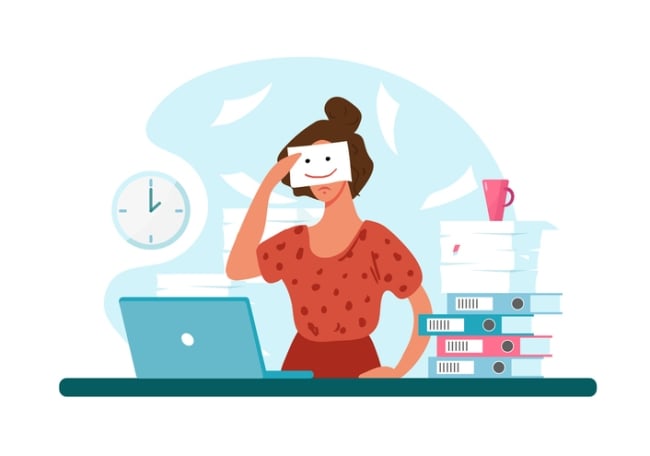You have /5 articles left.
Sign up for a free account or log in.

Tatyana Antusenok/Getty Images
High rates of isolation, loneliness and heightened stress and anxiety among students coping with the pandemic are an inescapable aspect of the work of college mental health therapists. As the public health crisis stretches on and approaches the one-year mark, the overworked professionals who provide mental health services to students are also feeling emotionally overburdened -- and are themselves seeking support from each other and their institutions.
Among the many negative consequences of the public health crisis, sad and stressed-out therapists was an unexpected but perhaps inevitable outcome.
Now students and counselors alike have been thrust into a “universal experience” of uncertainty and anxiety about the future, said David Walden, director of the mental health counseling center at Hamilton College, a private liberal arts institution in New York.
“We’re humans in the world, too,” he said. “If someone comes in to talk about the uncertainty of the pandemic, you can’t avoid that. You’re also living through the pandemic.”
A range of troubling surveys and studies about students’ mental well-being during the fall semester found that they are dealing with more symptoms of anxiety and depression than in previous years. And more often than not, mental health professionals are experiencing the same emotions as the students who seek their help, Walden said.
The increase in student demand for mental health services, which was already occurring before the pandemic was declared last March, has skyrocketed at some college mental health centers, as has the severity of the conditions for which they are seeking care. This has meant a heavier workload for the therapists who work in college counseling centers and the directors who oversee them, he said.
Therapists at Hamilton see up to 25 students for virtual counseling each week, said Walden, who's also a staff psychologist. He provides virtual therapy sessions for students from his bedroom and said it's challenging discussing their feelings of isolation during the pandemic while he's also isolated and unable to separate his work life from his home life.
As someone who has built a career helping students, Walden said it's been frustrating that he cannot provide a catch-all solution for their anguish, or his own.
"The visits that stick out are the ones where there’s really no clear path for something that will help," he said. "It’s the folks that are dealing with the same things we’re dealing with -- the isolation and impact of anxiety. We can’t change the reality of this time, and we can’t make the feelings go away magically."
The prevalence of self-reported anxiety and depression among students nationwide who sought help at their college counseling centers has risen steadily over the last decade, according to an annual report from the Center for Collegiate Mental Health, or CCMH, which released new data on Jan. 12 about the 2019-20 academic year.
The increased need for services has taken a toll on the counselors. A recent survey found widespread emotional exhaustion among these providers. About 90 percent of counselors and about 92 percent of center directors said that they experienced mental health burnout during the fall semester, according to the survey, which collected responses from nearly 140 staff members and was co-authored by Walden and published in a report by Mantra Health, a teletherapy platform that virtually connects students with licensed therapists.
Nearly 82 percent of the college therapists surveyed said the pandemic has “worsened or intensified my burnout and isolation” and 76 percent of directors said the same, according to the survey, which is representative of 120 different institutions. Forty percent of counselors agreed that they worked more hours than usual during the fall semester and said there is “too much on my plate,” the survey report said.
Ben Locke, director of counseling and psychological services at Pennsylvania State University, who also runs the CCMH, joked that he has felt burned out to the point of being “crispy” during the pandemic. Like many others who oversee their college’s mental health services, he had to quickly convert Penn State’s counseling center to function entirely via phone or videoconferencing when students were sent home due to the pandemic.
“The entire university is lumbering through these massive changes one after another,” Locke said.
The Mantra Health survey results showed that college counseling staff members had far higher rates of burnout during the pandemic than what is expected among all mental health care providers in a typical year. In 2018, the American Psychological Association estimated that between 21 and 61 percent of mental health practitioners over all experienced burnout, compared to about 90 percent of college-based practitioners who felt these effects during fall 2020, the survey report noted. The emotional exhaustion can have a detrimental impact on both counselors and their clients, causing providers to be “unable to feel compassion” for those who come to them for help, an APA report said.
When a college counselor -- or any person -- is burned out, they “withdraw inward,” Walden said. “You’re less emotionally available to other people” when experiencing burnout, he said.
Forty-five percent of therapists who responded to the Mantra Health survey said their “ability to provide quality care is compromised” due to their workload. But Walden said in his experience at Hamilton, counseling center staff members are able to power through and effectively serve students despite the burnout by sometimes suppressing their own feelings of emotional exhaustion. While this benefits students and the institution as a whole, it is not helpful for center counselors and directors, who internalize their stress, he said.
It has been helpful for Walden to see his own therapist, which he has done since well before the pandemic. He is open about seeking mental health support and encourages his staff members to do the same, he said.
Locke said college counselors, similar to those in other care-providing professions, can get into patterns of neglecting to care for themselves. They’ll skip lunch or work into the evenings to fit in more sessions with students, he said.
“It’s not uncommon for helpers to help themselves last,” he said. “It’s why those instructions on airplanes are so important -- ‘Put your mask on first before helping others’ -- because if you don’t take care of yourself first, it’s useless.”
Counselors at Penn State’s mental health center, which has about 60 clinical staff members, annually set limits for the number of therapy appointments they will provide in order to keep workloads reasonable, Locke said.
Harry Rockland-Miller, former director of counseling and psychological health at the University of Massachusetts, Amherst, said setting such limits for counselors is common practice for larger institutions. But at times of “significant” demand from students for mental health services, such as during the pandemic or at other points during a typical semester when students are in need of support, “people need to roll up their sleeves and do what they can.”
Rockland-Miller and Locke also noted that external expectations for the number of students seen and the types of services provided can sometimes outpace the capabilities of counseling centers, which can lead to added pressure and burnout among staff. Managing these expectations -- whether they come from college presidents, students or parents -- was a primary focus of the CCMH annual report this year, which encouraged institutions to evaluate the level of care their counseling center can feasibly provide in a given year based on their student body size, staffing, funding and demand levels, otherwise known as the center’s “clinical load index.”
“If expectations are unreasonable and beyond what the center has the capacity to provide, then there’s a disconnect that can lead to anxiety, worry or resentment,” said Rockland-Miller, who is also clinical adviser to Mantra Health and a co-author of the survey report on counselor burnout.
The “aspirational” expectations for counseling centers and their actual capabilities are often misaligned; for example, parents might be told during a campus tour that their student can seek weekly counseling with limited wait times, but in reality it might be difficult for a college to deliver on this promise, the CCMH report said.
“Any time that the expectations created for or by the counseling center are unreasonable, you’re going to experience burnout,” said Locke.
To improve burnout caused by the pandemic, nearly 31 percent of the counseling center directors and the therapists surveyed by Mantra Health showed interest in a workplace culture that encourages them to speak openly about their mental health challenges, according to the survey report. About 37 percent of the directors and counselors proposed an increase in “staff camaraderie and personal connections” with their fellow staff members as a way to combat burnout, the report said.
It’s “incumbent” for college administrations and center directors to promote an open and connected workplace, but staff members can also cultivate this culture on their own, said Walden, director of the center at Hamilton College. College counselors might be expected to be more willing to talk about their own mental health challenges or seek therapy because of their profession, but are just as influenced by the stigma of seeking help as others, Walden said.
“Even among those of us who are just really comfortable utilizing therapy, talking about therapy and are open about our own use of it, there’s internalized feelings of stigma,” he said. “No doubt that has to be true with clinicians, even though we would be more open to it because it’s what we do.”








